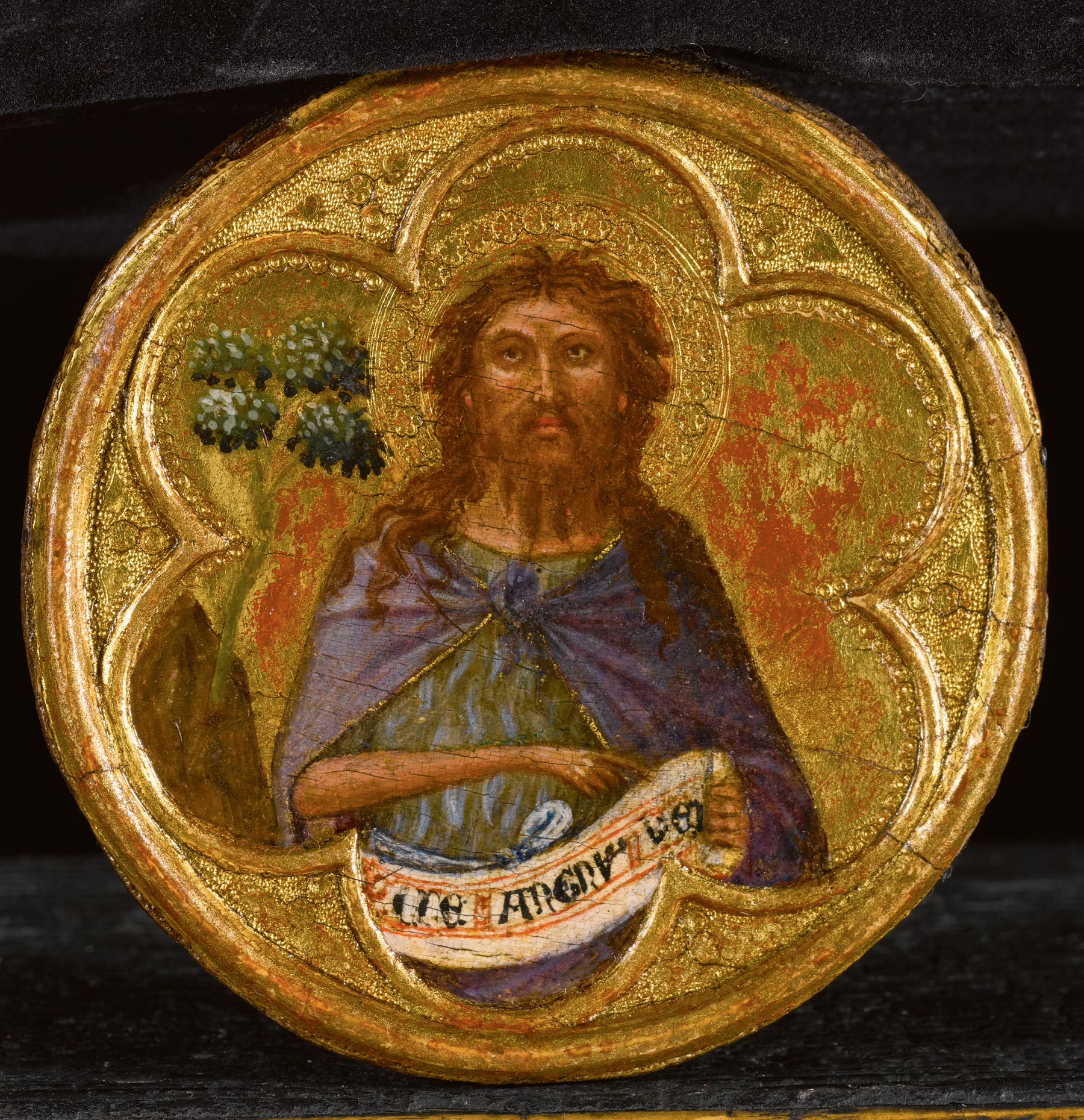San Benedetto fuori Porta Tufi, Siena, by 1734;1 James Jackson Jarves (1818–1888), Florence, by 1859
The panel support, of a vertical wood grain, retains its original thickness of 1.8 centimeters. It appears to have been trimmed slightly at the left, bottom, and right edges but not within the picture field, as a barb is evident along all three edges. The top edge has been truncated by an indeterminate amount. A full dowel hole, 7 millimeters in diameter, has been drilled into the left edge, 17.2 centimeters from the bottom of the panel. Three half-channels for dowels occur on the left and right edges, 2.5, 14.5, and 27.5 centimeters from the bottom. The purpose served by these dowels is unclear, unless they relate to a later framing structure not preserved today. The paint surface has been lightly abraded overall but is generally in a good state. Scattered local losses in and around the figure of the beggar chiefly affect his left leg. The shadowed inner wall of the city gate directly above Saint Martin’s left shoulder and between the legs of his horse was left in an abraded state after a cleaning of 1952–53 by Andrew Petryn and was subsequently inpainted by Patricia Garland in a cleaning of 2002. The latter campaign also saw retouching of losses in the right wall of the city gate and scattered throughout the buildings visible above the city wall at the top center, especially along a V-shaped loss above Saint Martin’s helmet.
Saint Martin, bishop of Tours, was, according to the thirteenth-century Golden Legend of Jacobus de Voragine, the son of a Roman legionary who served under the emperors Constantine and Julian. He was raised by his father in the garrison at Pavia and, although he was of spiritual inclination, he was pressed into military service at age fifteen by an imperial decree that the sons of veterans should assume their fathers’ commissions. In the winter of his eighteenth year, “he was passing through the city gate of Amiens when a poor man, almost naked, confronted him.”2 Drawing his sword, Martin cut his cloak in two and gave half to the beggar. “The following night he had a vision of Christ wearing the part of his cloak with which he had covered the beggar. . . . [Martin] saw this not as a reason for pride, but as evidence of God’s kindness, and had himself baptized.” In the painting, Saint Martin, mounted and dressed not as a Roman legionary but as a medieval knight, emerges from a city gate, riding along a cobbled highway. He encounters a nearly naked beggar at the left, to whom he hands the end of his fur-lined red cloak while he cuts it in half with his sword. The city walls behind the two figures are topped with a corbel arcade, and above them can be seen the upper stories and roofs of several buildings, rendered with an empirically accurate sense of proportion and solidity.
The Charity of Saint Martin has resisted accurate identification longer than any other of the most important paintings in the Jarves Collection at Yale. It was catalogued by Jarves and Russel Sturgis, Jr., as by Dello Delli, a fifteenth-century Florentine painter and sculptor much praised by Giorgio Vasari as the first to perfect the art of cassone decoration but by whom no documented works were, or are, known to survive.3 As they also attributed to Dello Delli the cassone in the Jarves Collection representing a tournament in Piazza Santa Croce, now recognized as the work of Apollonio di Giovanni,4 it is clear that this attribution was based exclusively on the narrative content and figure scale of the painting, and possibly on the fact that Saint Martin is portrayed wearing armor. As early as 1895, William Rankin realized that the painting must date earlier than the fifteenth century; shortly afterward, Bernard Berenson situated it firmly in the first half of the fourteenth century and moved its place of origin from Florence to Siena by attributing it to Simone Martini.5 Although he repeated this attribution through subsequent editions of his lists,6 it gained little traction beyond the initial cataloguing efforts of Osvald Sirén.7 It was rejected timidly by Raimond van Marle and more decisively by Richard Offner.8 Offner suggested instead an artist of a slightly later generation, Lippo Vanni, who at that time was believed to be the author of a painting of the Charity of Saint Nicholas in the Musée du Louvre, Paris (fig. 1), that would later come to be recognized as a pendant to the Yale Charity of Saint Martin. Offner’s proposal found an echo in the final version of Berenson’s lists, where the painting appears as “close to Lippo Vanni.”9 F. Mason Perkins believed the panel to be by a follower of Bartolo di Fredi, an artist then thought to have been responsible for most of the major developments in Sienese painting during the second half of the fourteenth century.10
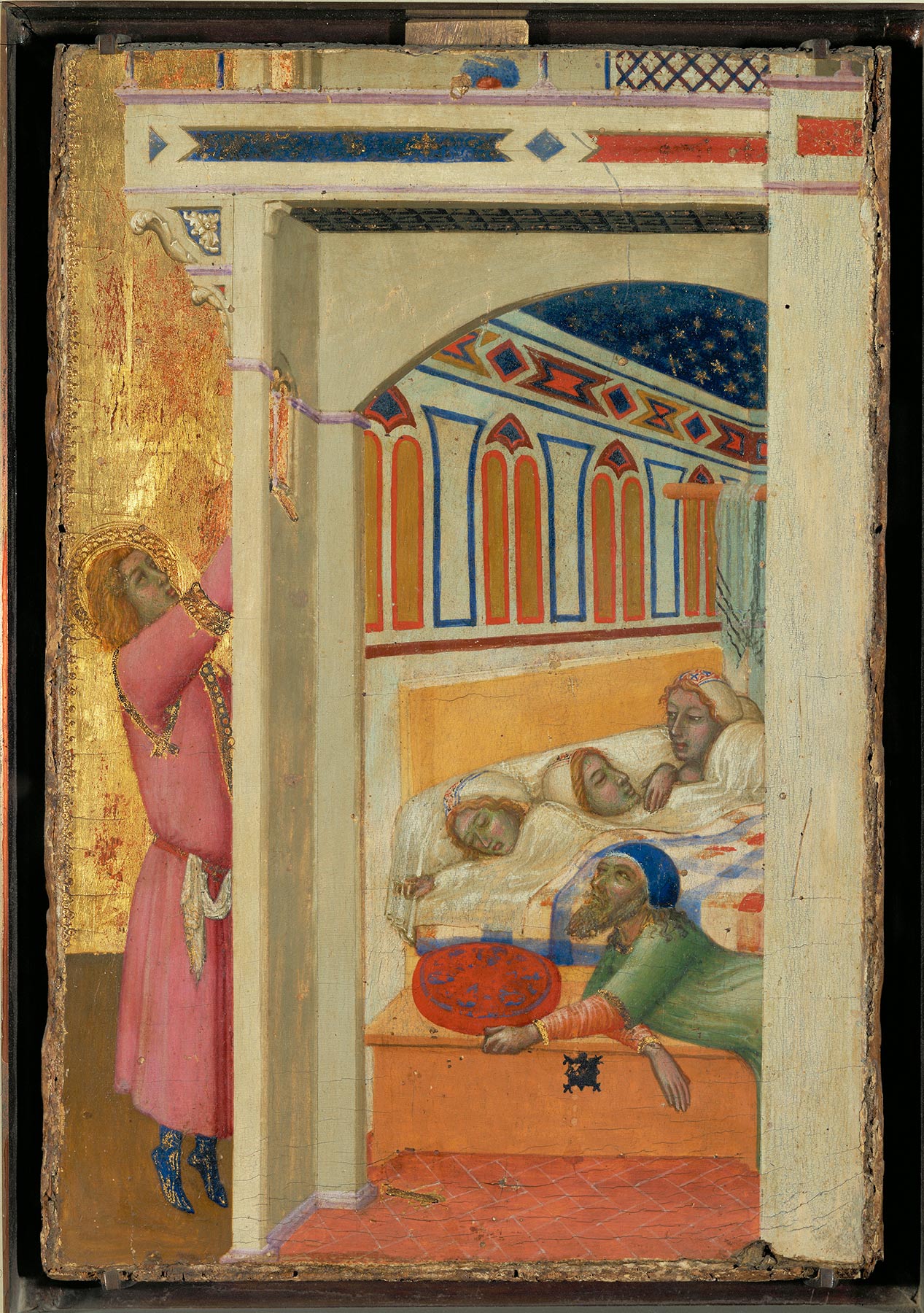
A breakthrough in discussions of the Charity of Saint Martin came in 1951, when Roberto Longhi asserted that the Louvre Charity of Saint Nicholas, which relates to the Yale panel in size, style, and subject, must have been part of a single complex with it and attributed both works to Ambrogio Lorenzetti.11 Although this identification is stubbornly and inexplicably credited to Federico Zeri throughout the English-language literature concerning the Charity of Saint Martin, the pairing has never been doubted. All subsequent discussion of both works has centered on identifying the complex from which they might have been removed and on whether the Yale panel was painted by Ambrogio Lorenzetti or in his workshop by an assistant. Doubts concerning Ambrogio’s authorship of this panel have been surprisingly persistent,12 perhaps due to the unconventional and stiff-legged portrayal of the horse upon which Saint Martin is mounted. Such doubts, however, are belied by the daring perspective of the scene, viewed as it develops moving forward in space; by the astonishing technical sophistication of the rendering of Saint Martin’s armor in tooled gold leaf and oil glazes; and by the complex and self-confident architectural detail that fills the upper third of the composition. In all these respects, the Yale panel may be compared favorably with Ambrogio’s scenes from the legend of Saint Nicholas from San Procolo in Florence, now in the Gallerie degli Uffizi.13 The Yale panel, unfortunately, is less well preserved than the truly remarkable scenes in the Uffizi, but it is certainly by the same hand and from a slightly later moment in his career. It is persuasively dated to the first half of the 1340s, close to the Annunciation for the Ufficio della Gabella, Siena, of 1344, in the most recent and most thorough discussion of it and its companion panels, the exemplary entry by Gina Lullo in the Ambrogio Lorenzetti exhibition catalogue of 2017.14
The other major point of contention in discussions of the Charity of Saint Martin is the identification of its original context and provenance. In 1967 Gordon Moran argued on the basis of style and iconography that the two narrative panels at Yale and the Louvre might have formed the wings of a triptych with the so-called Piccola Maestà by Ambrogio in the Pinacoteca Nazionale, Siena (fig. 2).15 Moran advanced physical evidence, in the form of dowel holes drilled into the sides of the panel, that the latter was indeed the center of a triptych or small altarpiece rather than an independent devotional work, as had previously been believed. The Piccola Maestà represents the Virgin and Child Enthroned, adored by six angels and six saints, among whom are two bishops who may be identifiable as Saints Martin of Tours and Nicholas of Bari. Moran interpreted the device represented on the parchment scroll held by the Christ Child as a ladder, emblem of the Spedale di Santa Maria della Scala, the foremost charitable institution in Renaissance Siena, which he adduced as thematic confirmation of his reconstruction. He also hypothesized that the Yale and Louvre panels had been cropped not only at their tops but also at their left and right edges, respectively, to account for the lack of matching dowel holes along the sides that would have abutted the Piccola Maestà standing between them. Cataloguing the Siena panel in 1977, Piero Torriti expressed only minor doubts about this reconstruction, emphasizing the qualitative difference he perceived between the splendid Charity of Saint Nicholas at the Louvre and the deficiencies of the Charity of Saint Martin at Yale.16 He rejected unequivocally the hypothetical provenance from the Spedale della Scala, noting that the device on the Christ Child’s scroll in the Piccola Maestà is not a ladder but the text “FIAT V[oluntas tua].” Torriti reported without comment that a 1735 inventory from the monastery of San Benedetto fuori Porta Tufi, called to his attention by Gordon Moran, might refer to the Siena, Louvre, and Yale panels, confirming that they had once stood together as a triptych.
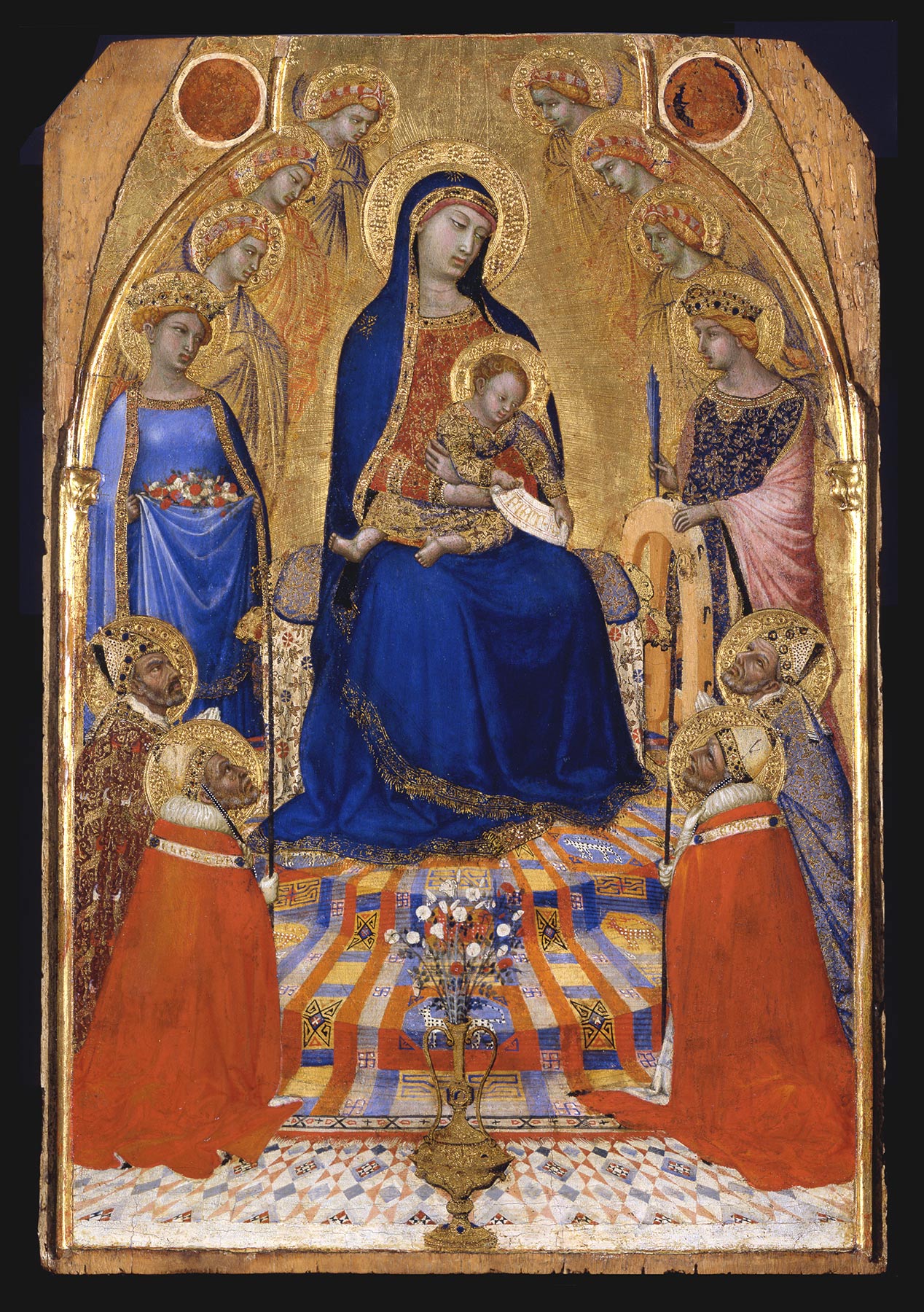
Creighton Gilbert, in an eccentric article of 1997, explored an altogether different avenue of inquiry.17 He noted conservation reports indicating that the Yale panel had not been trimmed on either of its lateral edges and concluded that it could not therefore have been part of a triptych with the Piccola Maestà. This conclusion was instinctual rather than evidentiary since he observed that the Yale panel preserves a dowel hole along its left edge (unknown to Moran in 1967). He insisted, on the one hand, that a narrative scene of this type is not generally encountered in the context of a triptych wing and, on the other, that the Yale and Louvre panels were not cut at their top edges and were therefore too small to have stood alongside the Piccola Maestà in a triptych. He contended that in both panels Ambrogio Lorenzetti must have decided to paint over the bare wood surround to extend the top edge of the composition in order to relieve the cramped projection of space within them. It may be inferred that Gilbert misunderstood the bare wood along the sides and bottom as areas of the picture surface that the artist had decided not to paint, whereas these, in fact, resulted from the removal of engaged frame moldings that had been applied before the artist began work on the painted image. The upper edge, too, would have been provided with an engaged molding, and it must be assumed therefore that both the Yale and Louvre panels have been cropped somewhere within the original picture field, although it is impossible to determine by how much. Gilbert also dismissed the evidence of the 1735 inventory linking the three panels in a single structure, claiming that, notwithstanding its great specificity in describing the unusual subjects of each of the three works, it cites their medium as oil rather than tempera and must therefore refer to some other objects.18
Gilbert’s conclusion, that the Yale and Louvre panels were painted to decorate the sides of an alms box, is based on iconographic interpretation only. It fails to take into account the function of the dowel in the left side of the Yale panel (evidence of a corresponding dowel in the Louvre panel was destroyed when its support was thinned to a depth of 6 millimeters; the dowel in the Yale panel is set 6.5 millimeters from the surface of the panel). Norman Muller instead reported that the dowel holes in the left edge of the Yale panel and the right edge of the Piccola Maestà are within 1 millimeter the same diameter, and both occur 17.5 centimeters from the bottom edge of their respective panels.19 Having demonstrated conclusively that the Yale, Siena, and Louvre panels did originate as a triptych, he then advanced an overscrupulous interpretation of the punch tooling in the three panels and an unsupportable reading of their style to suggest that the triptych might have been executed around midcentury, possibly after Ambrogio Lorenzetti’s death and certainly by members of his workshop. It was not until 2017, when the three panels were reunited in Siena on the occasion of the monographic exhibition dedicated to Ambrogio Lorenzetti at the Complesso Museale di Santa Maria della Scala, that their integrity as a group was reaffirmed and their position within Ambrogio’s oeuvre—as masterpieces from his last decade of activity—could be decisively established.
The chief difficulty with the reconstruction proposed graphically by Muller lies in its assumption that the Yale and Louvre panels once approximated the height of the Piccola Maestà much more closely than they do at present. To be sure, the presence of a second dowel hole on either side of the Siena panel implies that its wings were taller than the roughly 30 centimeters of these two panels as they have come down to us. It need not be assumed, however, that their missing height was fully occupied by a continuation of their present painted surfaces, as in Muller’s reconstruction, where a trilobe arch mirroring that of the center panel would have extended the painted architecture and gold ground in both panels to nearly 40 percent of their total height. While it is, of course, possible, it is difficult to imagine the artist lavishing that much attention on nonessential parts of either narrative. Equally possible, if not more so, is that each lateral was capped by a pinnacle framing an independent scene or figure, just as it is possible that the truncated top of the Piccola Maestà did not originally terminate in a simple gable, as is always imagined, but was crowned by a framing pinnacle. If this were the case, and if the missing pinnacles survive, three candidates present themselves on the basis of style and quality of execution. Two are matching triangular pediments showing half-length figures of Saint Agnes (fig. 3) and Saint Elizabeth of Hungary (fig. 4), measuring 37 by 25.1 and 36.5 by 25 centimeters, respectively, overall. In scale, these figures are considerably larger than any other figures in the triptych, except for the Virgin in the Piccola Maestà, but their painted surfaces are, at their bottom edges, exactly the same width as the Charity of Saint Martin and the Charity of Saint Nicholas. Their iconography continues that of the main panels of the triptych, unless one accepts the occasional proposal to identify the female saint at the left of the Maestà as Saint Elizabeth of Hungary rather than Saint Dorothy.20 In painting style and decorative details, the pinnacles correspond closely with the other panels of the triptych, and conversely, they do not relate well enough to any other surviving works by Ambrogio Lorenzetti to propose an alternative reconstruction for them. The third candidate, a roundel showing Saint John the Baptist clearly excised from the tympanum or spandrel of a gilded frame (fig. 5), is also closely related in style, technique of execution, and quality to the Piccola Maestà.21 No physical or iconographic evidence exists that can associate this roundel incontrovertibly with the missing pinnacles of either the Siena, Yale, or Louvre panels, but its possible relation to them cannot be excluded a priori.
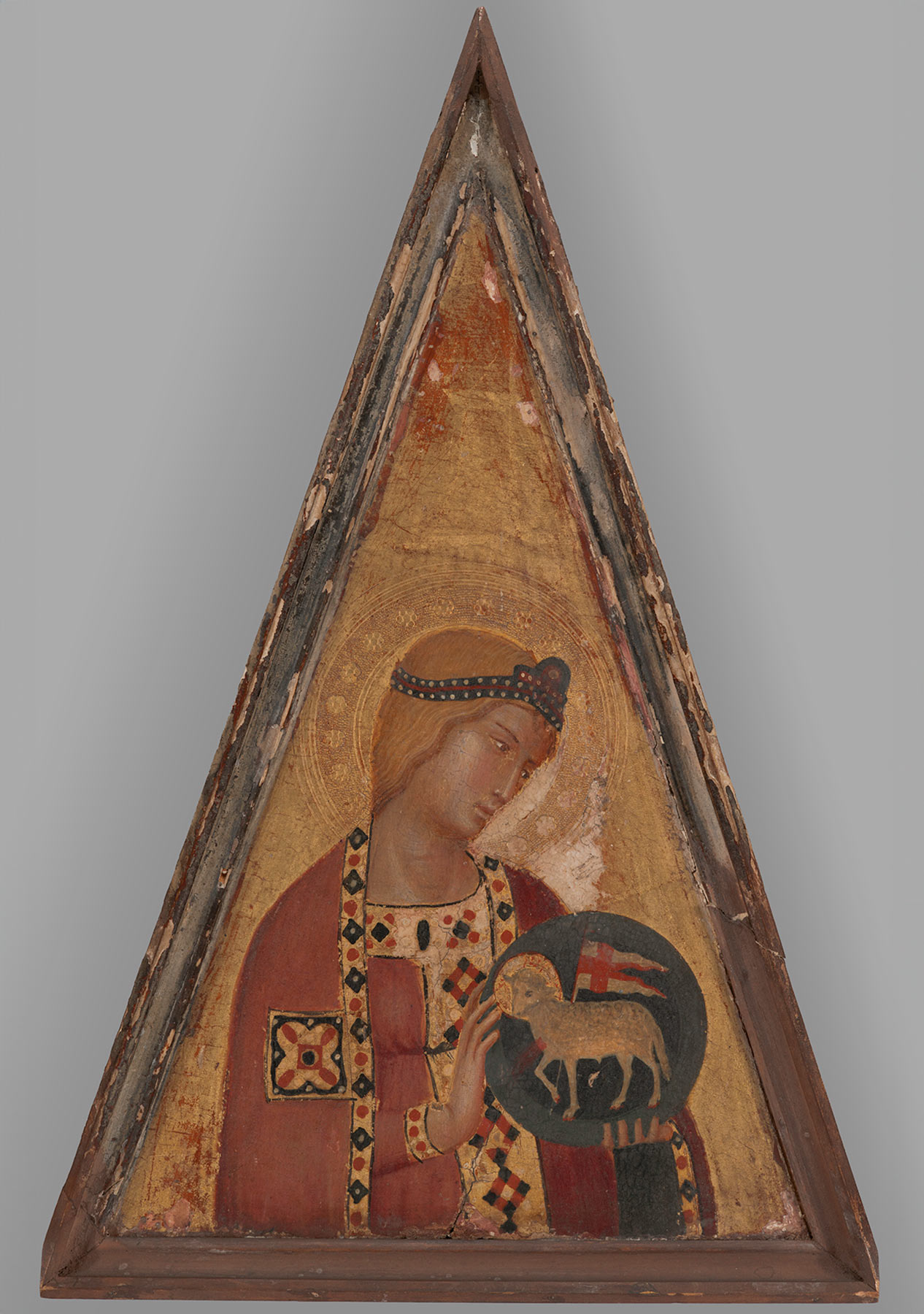
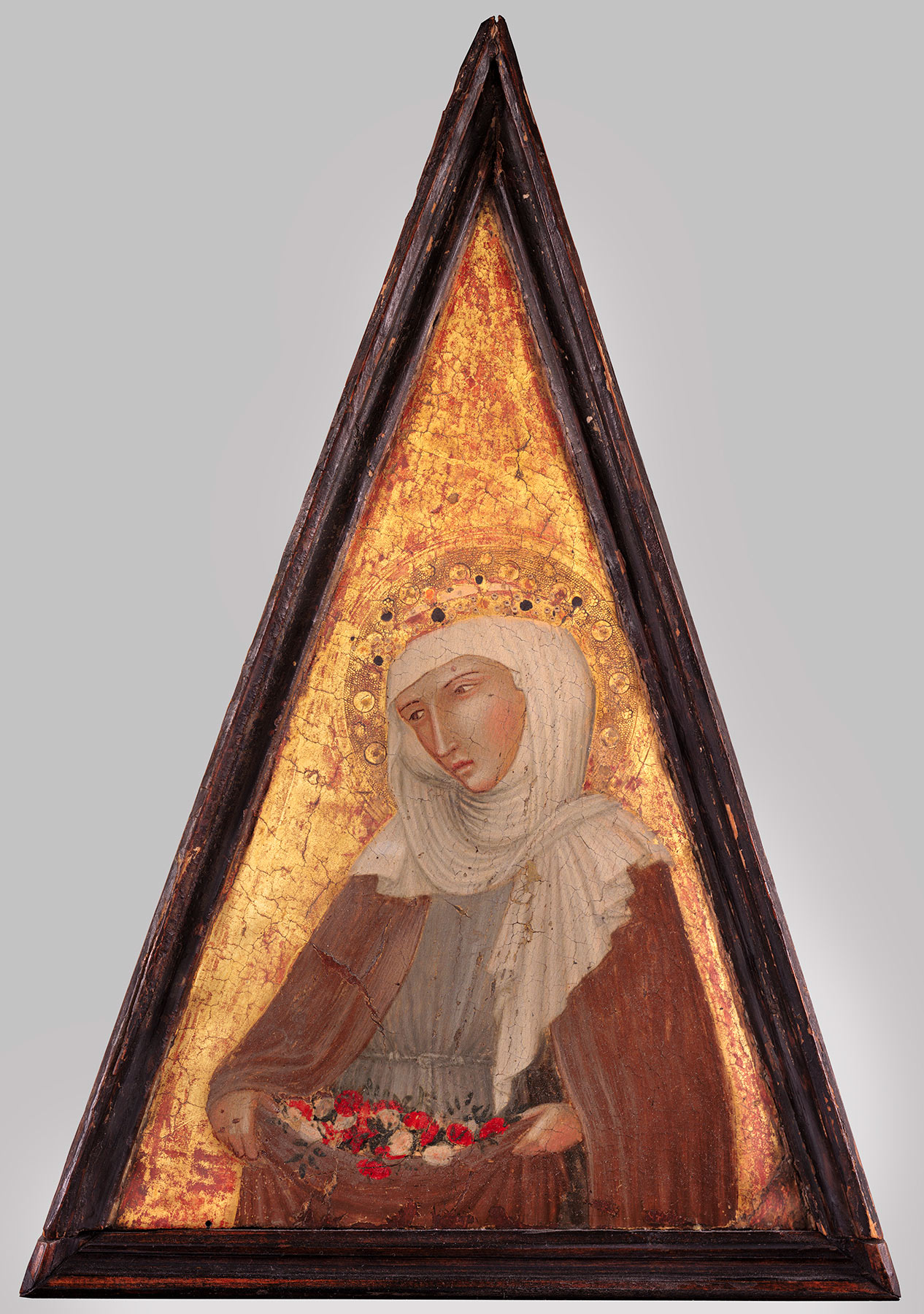
Discoursing on the seminal role played by Ambrogio Lorenzetti in the promulgation of naturalistic motifs in Italian, specifically Sienese, Renaissance painting, Gilbert called attention to what he believed was the highly original device of a shadow cast by Saint Martin’s cloak in the Yale Charity of Saint Martin. Although it cannot be doubted that Ambrogio Lorenzetti experimented with optical effects of this sort and was instrumental in their transmission to later generations of painters, the area in question in the Yale painting is not a cast shadow. It is the vertical face of a rocky bank bordering the paved road on which the saint rides out of the city gate at Amiens. —LK
Published References
Jarves, James Jackson. Descriptive Catalogue of “Old Masters” Collected by James J. Jarves to Illustrate the History of Painting from A.D. 1200 to the Best Periods of Italian Art. Cambridge, Mass.: H. O. Houghton, 1860., 49, no. 56; Sturgis, Russell, Jr. Manual of the Jarves Collection of Early Italian Pictures. New Haven: Yale College, 1868., 51–52; W. F. Brown, Boston. Catalogue of the Jarves Collection of Early Italian Pictures. Sale cat. November 9, 1871., lot 46; Rankin, William. “Some Early Italian Pictures in the Jarves Collection of the Yale School of Fine Arts at New Haven.” American Journal of Archaeology 10, no. 2 (April–June 1895): 137–51., 146; Berenson, Bernard. The Central Italian Painters of the Renaissance. New York: G. P. Putnam’s Sons, 1902., 252; Perkins, F. Mason. “Pitture senesi negli Stati Uniti.” Rassegna d’arte senese 1 (1905): 74–78., 74, 76; Rankin, William. Notes on the Collections of Old Masters at Yale University, the Boston Museum of Fine Arts, the Fogg Museum of Harvard University. Wellesley, Mass.: Department of Art, Wellesley College, 1905., 146; Sirén, Osvald. A Descriptive Catalogue of the Pictures in the Jarves Collection Belonging to Yale University. New Haven: Yale University Press, 1916., 35–36; van Marle, Raimond. Simone Martini et les peintres de son école. Strasbourg, France: J. H. E. Heitz, 1920., 81–82; Offner, Richard. Italian Primitives at Yale University: Comments and Revisions. New Haven: Yale University Press, 1927., 4–5, 38; Berenson, Bernard. Studies in Medieval Painting. New Haven: Yale University Press, 1930., 58; Berenson, Bernard. Italian Pictures of the Renaissance: A List of the Principal Artists and Their Works with an Index of Places. Oxford: Clarendon, 1932., 534; Liberati, Alfredo. “Il convento di Monteoliveto presso Siena.” Bullettino senese di storia patria 40 (1933): 235–47., 244–45; Berenson, Bernard. Pitture italiane del Rinascimento: Catalogo dei principali artisti e delle loro opera. Trans. Emilio Cecchi. Milan: Ulrico Hoepli, 1936., 459; “Picture Book Number One: Italian Painting,” special issue, Bulletin of the Associates in Fine Arts at Yale University 15, nos. 1–3 (October 1946): unpag., fig. 18; Longhi, Roberto. “Due resti di un paliotto di Ambrogio Lorenzetti.” Paragone 2, no. 13 (January 1951): 52–54., 52–54; Steegmuller, Francis. The Two Lives of James Jackson Jarves. New Haven: Yale University Press, 1951., 299, fig. 8; Moran, Gordon, Charles Seymour, Jr., and Enzo Carli. “The Jarves St. Martin and the Beggar.” Yale University Art Gallery Bulletin 31, no. 2 (Spring 1967): 28–39., 28–39; Berenson, Bernard. Italian Pictures of the Renaissance, A List of the Principal Artists and Their Works with an Index of Places: Central Italian and North Italian Schools. 3 vols. London: Phaidon, 1968., 1:221; Seymour, Charles, Jr. Early Italian Paintings in the Yale University Art Gallery. New Haven: Yale University Art Gallery, 1970., 72–75, no. 50; Fredericksen, Burton B., and Federico Zeri. Census of Pre-Nineteenth-Century Italian Paintings in North American Public Collections. Cambridge, Mass.: Harvard University Press, 1972., 599; Ritchie, Andrew Carnduff, and Katharine B. Neilson. Selected Paintings and Sculpture from the Yale University Art Gallery. New Haven: Yale University Press, 1972., no. 2; Charles Seymour, Jr., in Seymour, Charles, Jr., et al. Italian Primitives: The Case History of a Collection and Its Conservation. Exh. cat. New Haven: Yale University Art Gallery, 1972., 13, no. 5; Torriti, Piero. La Pinacoteca Nazionale di Siena: I dipinti dal XII al XV secolo. Genoa: Sagep, 1977., 122; Brejon de Lavergnée, Arnauld, and Dominique Thiébaut. Catalogue sommaire illustré des peintures du Musée du Louvre. Vol. 2, Italie, Espagne, Allemagne, Grande-Bretagne et divers. Paris: Éditions de la Réunion des Musées Nationaux, 1981., 195; Kenney, Elise K., ed. Handbook of the Collections: Yale University Art Gallery. New Haven: Yale University Art Gallery, 1992., 133; Gilbert, Creighton. “Ambrogio Lorenzetti’s Charitable Appeal.” Yale University Art Gallery Bulletin (1997–98): 30–41., 31–41; Muller, Norman E. “Ambrogio Lorenzetti’s ‘Small’ Maestà Reconsidered.” In Conservare necesse est: Festskrift til Leif Einar Plahter på hans 70-årsdag, ed. Erling S. Skaug, 214–25. Oslo: International Institute for Conservation of Historic and Artistic Works—Nordic Group, 1999., 214–24; Frugoni, Chiara, ed. Pietro e Ambrogio Lorenzetti. Florence: Le Lettere, 2002., 161; Gina Lullo, in Bagnoli, Alessandro, Roberto Bartalini, and Max Seidel, eds. Ambrogio Lorenzetti. Exh. cat. Milan: Silvana, 2017., 338–44
Notes
-
Gina Lullo, in Bagnoli, Alessandro, Roberto Bartalini, and Max Seidel, eds. Ambrogio Lorenzetti. Exh. cat. Milan: Silvana, 2017., 342, cites documents of 1734 and 1735, the latter published by Alfredo Liberati (in Liberati, Alfredo. “Il convento di Monteoliveto presso Siena.” Bullettino senese di storia patria 40 (1933): 235–47.), describing the triptych of which the Yale panel formed part in the foresteria at San Benedetto, the Olivetan monastery outside the walls of Siena. By 1752, the triptych had been dismantled and the wings, including the Yale panel, moved to the private apartments of the abbot Piccolomini. ↩︎
-
de Voragine, Jacobus. The Golden Legend. Trans. William Granger Ryan. 2 vols. Princeton, N.J.: Princeton University Press, 1993., 2:292. ↩︎
-
Jarves, James Jackson. Descriptive Catalogue of “Old Masters” Collected by James J. Jarves to Illustrate the History of Painting from A.D. 1200 to the Best Periods of Italian Art. Cambridge, Mass.: H. O. Houghton, 1860., 49, no. 56; and Sturgis, Russell, Jr. Manual of the Jarves Collection of Early Italian Pictures. New Haven: Yale College, 1868., 51–52. ↩︎
-
Yale University Art Gallery, inv. no. 1871.33, https://artgallery.yale.edu/collections/objects/290. ↩︎
-
Rankin, William. “Some Early Italian Pictures in the Jarves Collection of the Yale School of Fine Arts at New Haven.” American Journal of Archaeology 10, no. 2 (April–June 1895): 137–51., 146; Berenson, Bernard. The Central Italian Painters of the Renaissance. New York: G. P. Putnam’s Sons, 1902., 252. ↩︎
-
Berenson, Bernard. Italian Pictures of the Renaissance: A List of the Principal Artists and Their Works with an Index of Places. Oxford: Clarendon, 1932., 534; and Berenson, Bernard. Pitture italiane del Rinascimento: Catalogo dei principali artisti e delle loro opera. Trans. Emilio Cecchi. Milan: Ulrico Hoepli, 1936., 459. ↩︎
-
Sirén, Osvald. A Descriptive Catalogue of the Pictures in the Jarves Collection Belonging to Yale University. New Haven: Yale University Press, 1916., 35–36. ↩︎
-
van Marle, Raimond. Simone Martini et les peintres de son école. Strasbourg, France: J. H. E. Heitz, 1920., 81–82; Offner, Richard. Italian Primitives at Yale University: Comments and Revisions. New Haven: Yale University Press, 1927., 4–5, 38. ↩︎
-
Berenson, Bernard. Italian Pictures of the Renaissance, A List of the Principal Artists and Their Works with an Index of Places: Central Italian and North Italian Schools. 3 vols. London: Phaidon, 1968., 1:221. ↩︎
-
Perkins, F. Mason. “Pitture senesi negli Stati Uniti.” Rassegna d’arte senese 1 (1905): 74–78., 74, 76. ↩︎
-
Longhi, Roberto. “Due resti di un paliotto di Ambrogio Lorenzetti.” Paragone 2, no. 13 (January 1951): 52–54., 52–54. ↩︎
-
See Moran, Gordon, Charles Seymour, Jr., and Enzo Carli. “The Jarves St. Martin and the Beggar.” Yale University Art Gallery Bulletin 31, no. 2 (Spring 1967): 28–39., 28–39; Seymour, Charles, Jr. Early Italian Paintings in the Yale University Art Gallery. New Haven: Yale University Art Gallery, 1970., 72–75, no. 50; Charles Seymour, Jr., in Seymour, Charles, Jr., et al. Italian Primitives: The Case History of a Collection and Its Conservation. Exh. cat. New Haven: Yale University Art Gallery, 1972., 13, no. 5; Torriti, Piero. La Pinacoteca Nazionale di Siena: I dipinti dal XII al XV secolo. Genoa: Sagep, 1977., 122; Gilbert, Creighton. “Ambrogio Lorenzetti’s Charitable Appeal.” Yale University Art Gallery Bulletin (1997–98): 30–41., 31–41; and Muller, Norman E. “Ambrogio Lorenzetti’s ‘Small’ Maestà Reconsidered.” In Conservare necesse est: Festskrift til Leif Einar Plahter på hans 70-årsdag, ed. Erling S. Skaug, 214–25. Oslo: International Institute for Conservation of Historic and Artistic Works—Nordic Group, 1999., 214–24. ↩︎
-
Inv. nos. 1890 nn. 1848–49, https://catalogo.uffizi.it/it/29/ricerca/detailiccd/1185295/. ↩︎
-
Gina Lullo, in Bagnoli, Alessandro, Roberto Bartalini, and Max Seidel, eds. Ambrogio Lorenzetti. Exh. cat. Milan: Silvana, 2017., 338–44. ↩︎
-
Moran, Gordon, Charles Seymour, Jr., and Enzo Carli. “The Jarves St. Martin and the Beggar.” Yale University Art Gallery Bulletin 31, no. 2 (Spring 1967): 28–39., 28–39. ↩︎
-
Torriti, Piero. La Pinacoteca Nazionale di Siena: I dipinti dal XII al XV secolo. Genoa: Sagep, 1977., 122. ↩︎
-
Gilbert, Creighton. “Ambrogio Lorenzetti’s Charitable Appeal.” Yale University Art Gallery Bulletin (1997–98): 30–41., 31–41. ↩︎
-
“Tre quadri in tavola fatti a olio di penello antico buono rappresentanti, uno la Madonna col Bambino in braccio con dodici Santi che gli fanno corona, il secondo San Martino e il terzo San Niccolò di Bari facendo elemosina alle tre fanciulle, con cornici colorate, et dorate” (Three paintings in oil on panel in a good antique style, one representing the Virgin with the Child in her arms and twelve saints surrounding them, the second Saint Martin, and the third Nicholas of Bari giving alms to the three maidens, with gilded and painted frames); Gilbert, Creighton. “Ambrogio Lorenzetti’s Charitable Appeal.” Yale University Art Gallery Bulletin (1997–98): 30–41., 40n12. ↩︎
-
Muller, Norman E. “Ambrogio Lorenzetti’s ‘Small’ Maestà Reconsidered.” In Conservare necesse est: Festskrift til Leif Einar Plahter på hans 70-årsdag, ed. Erling S. Skaug, 214–25. Oslo: International Institute for Conservation of Historic and Artistic Works—Nordic Group, 1999., 214–24. ↩︎
-
S. D’Argenio, in Chelazzi Dini, Giulietta, ed. Il gotico a Siena: Miniature, pitture, oreficerie, oggetti d’arte. Florence: Centro Di, 1982., 150; and van Os, Henk. The Art of Devotion in the Late Middle Ages in Europe, 1300–1500. Princeton, N.J.: Princeton University Press, 1994., 68. ↩︎
-
The roundel, 9.9 centimeters in diameter, appeared at sale at Sotheby’s, New York, January 30, 2019, lot 2, with an attribution to Ambrogio Lorenzetti. It does not otherwise occur in the literature devoted to the artist. ↩︎
